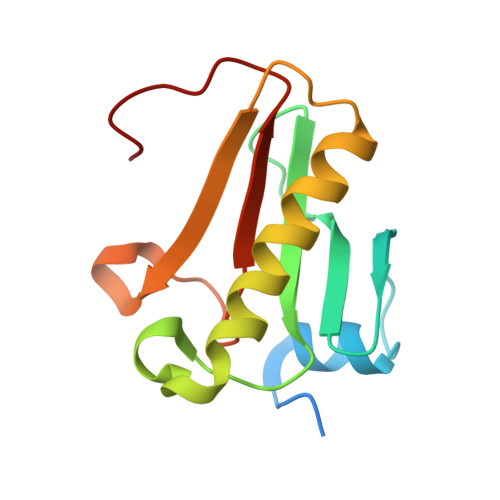Side chain independent recognition of aminoacyl adenylates by the hint1 transcription suppressor.
Wang, J., Fang, P., Schimmel, P., Guo, M.(2012) J Phys Chem B 116: 6798-6805
- PubMed: 22329685
- DOI: https://doi.org/10.1021/jp212457w
- Primary Citation of Related Structures:
4EQE, 4EQG, 4EQH - PubMed Abstract:
Human Hint1 suppresses specific gene transcription by interacting with the transcription factor MITF in mast cells. Hint1 activity is connected to lysyl-tRNA synthetase (LysRS), a member of the universal aminoacyl tRNA synthetase family that catalyzes specific aminoacylation of their cognate tRNAs, through an aminoacyl adenylate (aa-AMP) intermediate. During immune activation, LysRS produces a side-product diadenosine tetraphosphate (Ap(4)A) from the condensation of Lys-AMP with ATP. The pleiotropic signaling molecule Ap(4)A then binds Hint1 to promote activation of MITF-target gene transcription. Earlier work showed that Hint1 can also bind and hydrolyze Lys-AMP, possibly to constrain Ap(4)A production. Because Ap(4)A can result from condensation of other aa-AMP's with ATP, the specificity of the Hint1 aa-AMP-hydrolysis activity is of interest. Here we show that Hint1 has broad specificity for adenylate hydrolysis, whose structural basis we revealed through high-resolution structures of Hint1 in complex with three different aa-AMP analogues. Hint1 recognizes only the common main chain of the aminoacyl moiety, and has no contact with the aa side chain. The α-amino group is anchored by a cation-pi interaction with Trp123 at the C-terminus of Hint1. These results reveal the structural basis for the remarkable adenylate surveillance activity of Hint1, to potentially control Ap(4)A levels in the cell.
Organizational Affiliation:
Department of Cancer Biology, The Scripps Research Institute, Scripps Florida, 130 Scripps Way, Jupiter, Florida 33458, USA.
















